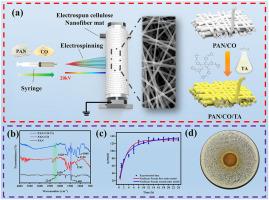Our official English website, www.x-mol.net, welcomes your
feedback! (Note: you will need to create a separate account there.)
Electrospun hydrophilic PAN/CO/TA composite nanofibrous membrane for adsorbing Cu(II) in water
Polymer ( IF 4.1 ) Pub Date : 2024-11-12 , DOI: 10.1016/j.polymer.2024.127829 Baiqing Yu, Yanling Xu, Jianliang Nie, Dingfan Li, Zijuan Su, Zhi Huang, Xiaocan Zhang, Weibin Wu, Hai Li, Wuyi Zhou, Wenxu Zheng
Polymer ( IF 4.1 ) Pub Date : 2024-11-12 , DOI: 10.1016/j.polymer.2024.127829 Baiqing Yu, Yanling Xu, Jianliang Nie, Dingfan Li, Zijuan Su, Zhi Huang, Xiaocan Zhang, Weibin Wu, Hai Li, Wuyi Zhou, Wenxu Zheng

|
In this paper, a novel polyacrylonitrile (PAN)/collagen (CO)/tannic acid (TA) composite nanofiber membrane for the adsorption of Cu(II) in water was prepared. The nanofibrous membranes were characterized by Fourier transform infrared (FTIR), scanning electron microscopy (SEM), thermogravimetric (TG), and water contact angle (WCA) techniques, and their adsorption performance on Cu(II) in water was tested. The results showed that incorporating CO improved the hydrophilic performance of the membranes, and the contact angle of PAN/CO decreased from 60.57° to 39.16° with the increase of CO content, which exhibited good hydrophilicity. Moreover, CO effectively crosslinked TA, so that TA was well fixed on the surface of the fiber membrane, and the resulting PAN/CO/TA composite nanofiber membrane had good fiber morphology, uniform fiber diameter distribution, with an average diameter of 292.22 nm, and good adsorption performance for Cu(II), up to 133.26 mg/g. The adsorption kinetics fitting showed that the adsorption mechanism was mainly electrostatic adsorption and chelation of Cu(II) by phenoxy anion. PAN/CO/TA and PAN/CO/TA/Cu nanofiber membranes showed bacteriostatic effects on E. coli and S. aureus, with PAN/CO/TA/Cu nanofiber membranes being particularly effective, with the average inhibition bands for E. coli and S. aureus being 7.50 mm and 10.05 mm, respectively. The distribution of the electric field during the spinning process was also simulated by finite element analysis in this study. Since TA is a natural polymer of plant origin and CO is of animal origin, it provides an environmentally friendly and cost-effective method to remove Cu(II) from water.
中文翻译:

一种用于吸附水中Cu(II)的电纺亲水PAN/CO/TA复合纳米纤维膜
本文制备了一种新型聚丙烯腈 (PAN)/胶原蛋白 (CO)/单宁酸 (TA) 复合纳米纤维膜,用于吸附水中 Cu(II)。采用傅里叶变换红外 (FTIR)、扫描电子显微镜 (SEM)、热重 (TG) 和水接触角 (WCA) 技术对纳米纤维膜进行表征,并测试了它们对水中 Cu(II) 的吸附性能。结果表明,掺入 CO 提高了膜的亲水性能,随着 CO 含量的增加,PAN/CO 的接触角从 60.57° 降低到 39.16°,表现出良好的亲水性。此外,CO 有效地交联了 TA,使 TA 很好地固定在纤维膜表面,所得的 PAN/CO/TA 复合纳米纤维膜具有良好的纤维形态,纤维直径分布均匀,平均直径为 292.22 nm,对 Cu(II) 具有良好的吸附性能,高达 133.26 mg/g。吸附动力学拟合表明,吸附机理主要是苯氧基阴离子对 Cu(II) 的静电吸附和螯合。PAN/CO/TA 和 PAN/CO/TA/Cu 纳米纤维膜对大肠杆菌和金黄色葡萄球菌表现出抑菌作用,其中 PAN/CO/TA/Cu 纳米纤维膜特别有效,对大肠杆菌和金黄色葡萄球菌的平均抑制条带分别为 7.50 mm 和 10.05 mm。本研究还通过有限元分析模拟了纺纱过程中电场的分布。由于 TA 是植物来源的天然聚合物,而 CO 是动物来源的,因此它提供了一种从水中去除 Cu(II) 的环保且经济高效的方法。
更新日期:2024-11-13
中文翻译:

一种用于吸附水中Cu(II)的电纺亲水PAN/CO/TA复合纳米纤维膜
本文制备了一种新型聚丙烯腈 (PAN)/胶原蛋白 (CO)/单宁酸 (TA) 复合纳米纤维膜,用于吸附水中 Cu(II)。采用傅里叶变换红外 (FTIR)、扫描电子显微镜 (SEM)、热重 (TG) 和水接触角 (WCA) 技术对纳米纤维膜进行表征,并测试了它们对水中 Cu(II) 的吸附性能。结果表明,掺入 CO 提高了膜的亲水性能,随着 CO 含量的增加,PAN/CO 的接触角从 60.57° 降低到 39.16°,表现出良好的亲水性。此外,CO 有效地交联了 TA,使 TA 很好地固定在纤维膜表面,所得的 PAN/CO/TA 复合纳米纤维膜具有良好的纤维形态,纤维直径分布均匀,平均直径为 292.22 nm,对 Cu(II) 具有良好的吸附性能,高达 133.26 mg/g。吸附动力学拟合表明,吸附机理主要是苯氧基阴离子对 Cu(II) 的静电吸附和螯合。PAN/CO/TA 和 PAN/CO/TA/Cu 纳米纤维膜对大肠杆菌和金黄色葡萄球菌表现出抑菌作用,其中 PAN/CO/TA/Cu 纳米纤维膜特别有效,对大肠杆菌和金黄色葡萄球菌的平均抑制条带分别为 7.50 mm 和 10.05 mm。本研究还通过有限元分析模拟了纺纱过程中电场的分布。由于 TA 是植物来源的天然聚合物,而 CO 是动物来源的,因此它提供了一种从水中去除 Cu(II) 的环保且经济高效的方法。


















































 京公网安备 11010802027423号
京公网安备 11010802027423号